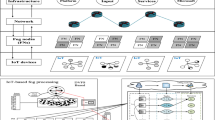Abstract
In the case of large-scale concurrent multimedia services, the resource utilization, QoS guarantee ability and system execution efficiency of distributed multimedia systems are facing many challenges. In order to further solve the above problems, this paper introduces fog computing into distributed multimedia systems and large-scale concurrent multimedia services, and considers the privacy protection of location services. Firstly, in order to solve the limitations of computing, storage, energy continuity, network access and other aspects of the fog node mobile devices, the framework of the fog computing multimedia information service system is constructed to obtain accurate location service data of the mobile terminal. At the same time, collaborative control of fog nodes, fog computing support nodes, public networks and other devices, to achieve the various functions of multimedia services. Secondly, to further improve the efficiency and security of fog computing, this section studies the time slice, bandwidth, hardware and other network resource allocation and management algorithms. Finally, the superiority and feasibility of the proposed algorithm in enhancing QoS performance are validated from different aspects of mathematical analysis and simulation experiments. For example, the resource utilization of multimedia system is increased by 1.34 times, and the load balancing capability and real-time guarantee are improved.









Similar content being viewed by others
References
Stephen R, Moulton II, Thomas L (2016) Beitinger, Kenneth W. Stewart, et al. joint application-architeture design space exploration of multimedia applications on many-core platforms - an experimental analysis[J]. Multimed Tools Appl 75(18):1–20
Stojmenovic I, Wen S, Huang X, Luan H (2016) An overview of fog computing and its security issues[J]. Concurr Comput Pract Exp 28(10):2991–3005
Santosa H, Ikaruga S, Kobayashi T (2016) 3D interactive simulation system (3DISS) using multimedia application authoring platform for landscape planning support system ☆[J]. Procedia So Behav Sci 227:247–254
Zhou B (2016) Smart classroom and multimedia network teaching platform application in college physical education teaching[J]. Int J Smart Home 10(10):145–156
Aazam M, Huh EN (2016) Fog computing: the cloud-IoT\/IoE middleware paradigm[J]. IEEE Potentials 35(3):40–44
Alrawais A, Alhothaily A, Hu C, Cheng X (2017) Fog computing for the internet of things: security and privacy issues[J]. IEEE Internet Comput 21(2):34–42
Kawai M, Ida A, Nakajima K (2018) Hierarchical parallelization of multi-coloring algorithms for block IC preconditioners[C]// IEEE, international conference on high PERFORMANCE computing and communications; IEEE, international conference on Smart City; IEEE, international conference on data science and systems. IEEE, 138–145
Ho DK, Chehida KB, Miramond B et al (2018) Towards a multi-mission QoS and energy manager for autonomous Mobile robots[C]// IEEE international conference on robotic computing. IEEE Comput Soc:270–273
Tu F, Yin S, Ouyang P, et al. (2018) Reconfigurable architecture for neural approximation in multimedia computing[J]. IEEE Trans Circuits Syst Video Technol PP(99):1–1
Musthaq SA, Salem O, Lohr C et al (2018) Policy-based QoS Management for Multimedia Communication[J]. Ifip Int Fed Inf Process 63(1):3068–3078
Sivaprakash C, Pauline A (2017) Configuring Linux system for internet protocol based multimedia communication network[J]. Indian J Sci Technol 10(7):1–6
Aazam M, Huh EN (2014) Fog computing and smart gateway based communication for cloud of things[C]// international conference on future internet of things and cloud. IEEE: 464–470
Alrawais A, Alhothaily A, Hu C, et al. (2017) An attribute-based encryption scheme to secure fog communications[J]. IEEE Access PP(99):1–1
Marques B, Machado I, Sena A, et al. (2017) A communication protocol for fog computing based on network coding applied to wireless sensors[C]// international symposium on computer architecture and high-PERFORMANCE computing workshops. IEEE Comput Soci: 109–114
Luo J (2017) Multimedia big data frame combination storage strategy based on virtual space distortion[J]. Int J Online Eng 13(2):119
Sharma V, Lim J D, Kim J N, et al. (2017) SACA: Self-aware communication architecture for IoT using mobile fog servers[J]. Mob Inf Syst (2017-4-11), 2017, 2017(1)
Rahman MA, Hossain MS, Hassanain E, Muhammad G (2018) Semantic multimedia fog computing and IoT environment: sustainability perspective[J]. IEEE Commun Mag 56(5):80–87
Hong HJ, Chuang JC, Hsu CH (2017) Animation rendering on multimedia fog computing platforms[C]// IEEE international conference on cloud computing technology and science. IEEE: 336–343
Rosário D, Schimuneck M, Camargo J, Nobre J, Both C, Rochol J, Gerla M (2018) Service migration from cloud to multi-tier fog nodes for multimedia dissemination with QoE support[J]. Sensors 18(2):329
Jalali F, Hinton K, Ayre R, Alpcan T, Tucker RS (2016) Fog computing may help to save energy in cloud computing[J]. IEEE J Sel Areas Commun 34(5):1728–1739
Acknowledgments
This work is supported in part by the National Natural Science Foundation of China (No. 61802115, No. 61401512), Henan province science and technology projects (No. 182102310925), and Key scientific research projects of Henan Province Education Department (No.18A520004).
Author information
Authors and Affiliations
Corresponding author
Additional information
This article is part of the Topical Collection: Special Issue on Fog/Edge Networking for Multimedia Applications
Guest Editors: Yong Jin, Hang Shen, Daniele D'Agostino, Nadjib Achir, and James Nightingale
Publisher’s note
Springer Nature remains neutral with regard to jurisdictional claims in published maps and institutional affiliations.
Rights and permissions
About this article
Cite this article
Chen, Y., Wang, Y. & Gong, D. Fog computing support scheme based on fusion of location service and privacy preservation for QoS enhancement. Peer-to-Peer Netw. Appl. 12, 1480–1488 (2019). https://doi.org/10.1007/s12083-019-00722-6
Received:
Accepted:
Published:
Issue Date:
DOI: https://doi.org/10.1007/s12083-019-00722-6




